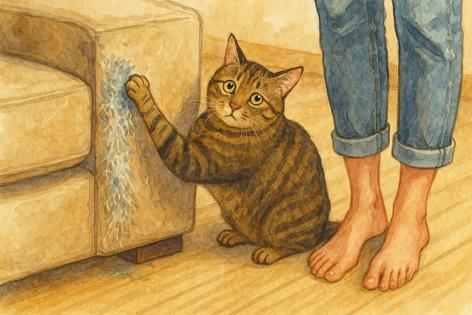Cat Clawing: Understanding, Managing and Respecting the Scratch
Published in Cats & Dogs News
Cats claw and scratch for reasons that are both instinctive and essential to their well-being. While many owners see clawing as misbehavior, for cats it’s a daily necessity, woven deep into their biology. Scratching helps remove the outer husk of their claws, keeping them sharp and healthy. It’s also a form of exercise — stretching the spine, shoulders and paws in one fluid motion.
There’s a social element, too. Cats have scent glands in their paws, and scratching leaves behind their signature. It’s both a territorial message to other animals and a kind of diary entry for themselves. In multi-cat households, you might see several cats using the same scratching post in rotation, each layering their scent over the others like feline graffiti.
Clawing is not an act of rebellion. It’s part of being a cat. Framing it this way can shift frustration into understanding, which is the first step to solving the problem.
Common Trouble Spots
Despite its natural role, scratching becomes an issue when cats choose inappropriate targets. Sofas, curtains, carpets, and even door frames often bear the brunt. These spots are usually tall, stable, and located in social hubs of the house — which is exactly why cats pick them.
A classic pattern: a new couch arrives, smells foreign, and becomes an irresistible billboard for claw marks. Another common trigger is stress or boredom. Indoor cats without enough stimulation may scratch more as a form of self-soothing or energy release.
Some cats develop favorite surfaces (vertical versus horizontal) or materials (rough jute, soft carpet, corrugated cardboard). Knowing your cat’s preferences is key to redirecting their claws somewhere acceptable.
Providing Proper Outlets
The most effective approach is to give cats places they want to scratch. Start by adding sturdy scratching posts or horizontal scratchers made from sisal, cardboard or carpet. Place them near your cat’s usual scratching spots — especially by favorite napping areas, because cats often scratch when they wake.
Stability matters. A wobbly post won’t get used. For vertical scratching, posts should be tall enough for a full-body stretch — ideally at least 3 feet. Multi-surface scratchers, cat trees and wall-mounted scratch pads can give variety and keep things interesting.
To draw them to the right spots, sprinkle catnip on new scratchers or play with toys around them. Praise your cat when they use it. Over time, this reinforces good scratching habits while giving your furniture a break.
Discouraging the Wrong Targets
While encouraging proper scratching, you also need to make forbidden spots less appealing. One approach is to temporarily cover furniture corners or arms with double-sided tape, plastic shields, or even aluminum foil. The texture deters scratching without harming the cat.
Scent can help too. Citrus sprays or synthetic feline pheromones (like Feliway) can make marked spots less inviting. If a cat has already scratched an area, clean it well to remove scent markers that might draw them back.
Be consistent. If you block off a favorite armchair but leave a similar one unprotected, your cat will just switch targets. Redirecting behavior takes patience, but most cats will eventually choose the option that feels best — which, ideally, is their own scratching post.
Trimming and Alternatives
Regular nail trims can reduce damage while you work on behavior. Many cats tolerate trimming if it’s done gently and from a young age, but even adult cats can learn with patience. Aim for every two to three weeks, snipping just the sharp tips.
Another option is plastic nail caps, which are glued over the claws and shed naturally as nails grow. They blunt scratching damage but don’t stop the behavior itself.
What should never be considered is declawing. Declawing is not simply a nail trim — it’s an amputation of the last bone of each toe, akin to removing the tips of a person’s fingers. It can cause lifelong pain, behavioral changes, and balance issues. Many countries ban it, and most veterinary associations strongly discourage it. Managing scratching humanely is safer and kinder.
Clawing as Communication
Sometimes scratching is more than maintenance — it’s a message. Sudden increases in scratching can signal stress or anxiety. A new pet, a move, or even furniture rearrangement can throw a cat’s world off balance. In these cases, scratching helps them cope.
If stress seems likely, give them safe retreats, predictable routines, and extra playtime. Puzzle feeders, window perches and vertical spaces like cat trees can help your cat feel secure and mentally engaged.
By recognizing scratching as emotional expression, not defiance, you can respond with empathy rather than punishment — which only damages trust without solving the problem.
Creating Harmony
The long-term solution isn’t to stop scratching but to channel it. Your cat will always need to scratch. The challenge is simply shaping where and how they do it. This takes a blend of understanding their instincts, reshaping their environment, and practicing consistency.
In the end, managing clawing is about respecting the cat’s nature while protecting your home. With the right balance of outlets, redirection, and patience, most cats will happily trade your sofa for a sisal post. And in doing so, they get to be what they are — agile, expressive creatures — without turning your living room into their art project.
========
This article was created, in part, utilizing AI tools.









Comments